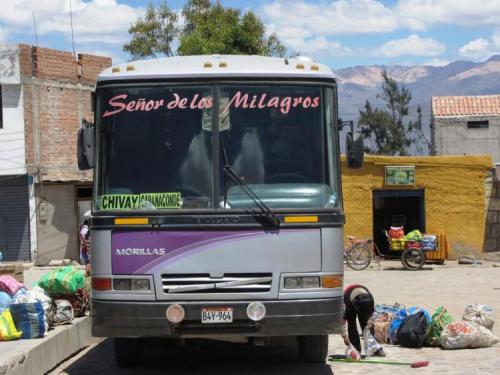Investigating the Past in the Present: Archaeology and Community in Cusco, Peru
R. Sandy Hunter, PhD Candidate, Department of Anthropology
Peru’s ‘Sacred Valley,’ the drainage of the Urubamba River, is flooded with foreign tourists daily. They flock to its many famous archaeological sites, and use it as a jumping off point for treks and trains to Machu Picchu. By contrast, the Patacancha Valley, which is immediately adjacent, sees very few foreign visitors. Most gringos who visit the Patacancha Valley go for a specific purpose: to visit the archaeological ruins of Pumamarka, an immense Inka settlement surrounded by an impressive wall that sits on a ridge above the valley floor. A few continue beyond Pumamarka, passing by another archaeological site—Marca Cocha—to visit the Quechua speaking community of Huilloc. In Huilloc they have the opportunity to spend the night with local families, witnessing first hand the lives of agriculturalists living in the Andes Mountains. In Huilloc, tourists might, for instance, accompany local herders as they care for the alpaca and sheep that provide the raw wool for the incredibly intricate textiles produced by hand in the community.
Like those tourists, I am an outsider in Huilloc. I am in the village to speak with community members about the possibility of collaborating on an archaeology project. I am interested in the lesser known of the major archaeological sites in the Patacancha Valley. Marca Cocha, I think, would be an ideal site for my dissertation research on the social and ecological changes that accompanied Spanish Colonialism in the region. Having visited the site numerous times, I know that there is evidence of occupation at the site during both the Inka and the Colonial periods. I want to begin an archaeological project investigating the transition from Inka to Colonial administration, but I must first speak with the community of Huilloc—will they support a project as collaborators?
Each month, the entire community meets to discuss issues that impact them all: land and water rights, the election of community officials, and the administration of community buildings. The meeting is conducted in Quechua. I only know a few words so I am only able to follow along at certain moments, taking my cues from the body language and quick translations whispered to me by other Spanish speakers. The first speakers are not from Huilloc. They came from a larger town within the same municipality to speak against the mayor of the region, they claim corruption and malfeasance, and make their point over the course of almost an hour. An hour up, they are followed by the very official they are speaking against. The mayor had arrived midway through the speeches against him in order to have the opportunity to defend himself—word does travel fast.
A property dispute is settled, the leader of the community watch ‘ronda’ is elected, and finally it is my turn to speak. As I get up, it is immediately clear that only a few of the several hundred people at the meeting have any interest in what I have to say. I introduce myself and my intentions: I want to initiate a collaborative relationship with community members, wherein we can together investigate the past of the region. There is little reaction. The possibility of a future collaboration with an archaeology project not yet even established is of little relevance compared to the immediate importance of land rights and political corruption.
I am initially disappointed by the lack of lack of interest in my project. Having been unable to catch a car back out of the Valley, I am forced to walk the twelve kilometers. During this walk I reflect upon the meeting and my perspective changes. The meeting reminds me that as much as the landscapes and ruins of the Patacancha Valley fascinate me as historical artifacts and as much as I can see the past through them, these remnants are more than historical reminders of the past in the present. These ruins connect that past to the present, and act in it. They have a contemporary existence that is embroiled in local politics—they are managed by the community and occasionally bring tourists—however, they do not take precedence over the pressing affairs of day to day life. My concerns—those of a hypothetical archaeological project, a year away—are not important. As an archaeologist I had been concentrating on the past of the Patacancha Valley, the Inka and Colonial ruins that initially drew me to the area. While studying the site of Marca Cocha—its seventeenth-century chapel, Inka buildings, and the ruins of pre-Inka structures—the contemporary Patacancha Valley had faded from prominence. My reception at the community meeting reminded me that an archaeology project based in the Patacancha Valley will only be a success if it both informs on the historical past and contributes tangibly to the lives of the people who live in the Valley.
 A group of classic Inka elite structures at the archaeological site of Marca Cocha, in Peru’s Patacancha Valley.
A group of classic Inka elite structures at the archaeological site of Marca Cocha, in Peru’s Patacancha Valley.
 A colonial chapel at the site of Marca Cochca, this chapel has been in use for at least 250 years.
A colonial chapel at the site of Marca Cochca, this chapel has been in use for at least 250 years.
 A woman weaving in the community of Huilloc. In Huilloc textile manufacturing begins with herding sheep and llamas, and includes each step of the process: dying, spinning, and weaving are all tasks completed in the community.
A woman weaving in the community of Huilloc. In Huilloc textile manufacturing begins with herding sheep and llamas, and includes each step of the process: dying, spinning, and weaving are all tasks completed in the community.
The contents of this blog do not necessarily reflect the views of the Center for Latin American Studies or the University of Chicago.






